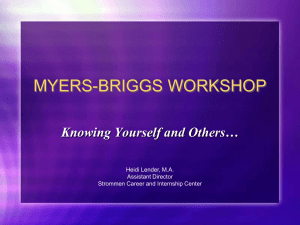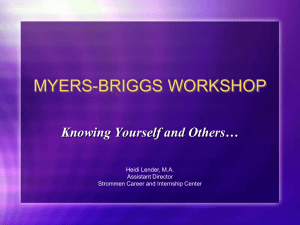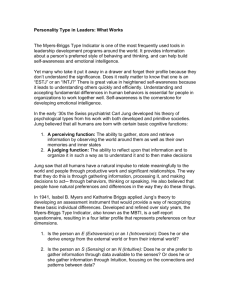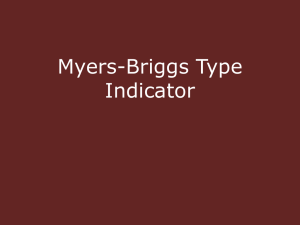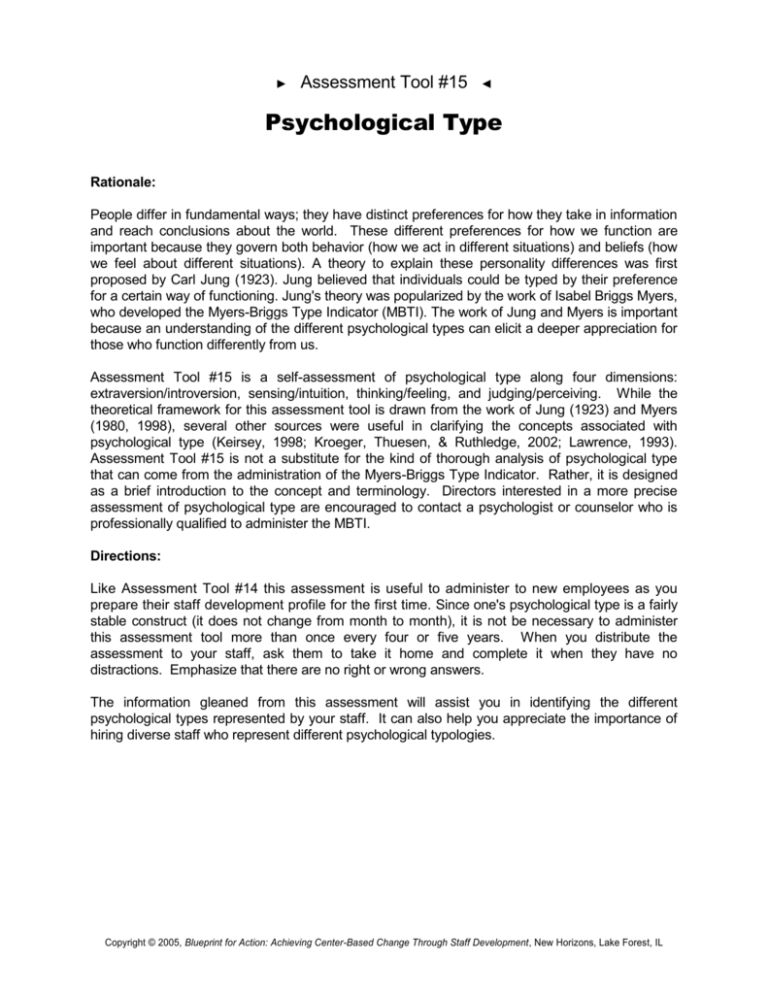
►
Assessment Tool #15
◄
Psychological Type
Rationale:
People differ in fundamental ways; they have distinct preferences for how they take in information
and reach conclusions about the world. These different preferences for how we function are
important because they govern both behavior (how we act in different situations) and beliefs (how
we feel about different situations). A theory to explain these personality differences was first
proposed by Carl Jung (1923). Jung believed that individuals could be typed by their preference
for a certain way of functioning. Jung's theory was popularized by the work of Isabel Briggs Myers,
who developed the Myers-Briggs Type Indicator (MBTI). The work of Jung and Myers is important
because an understanding of the different psychological types can elicit a deeper appreciation for
those who function differently from us.
Assessment Tool #15 is a self-assessment of psychological type along four dimensions:
extraversion/introversion, sensing/intuition, thinking/feeling, and judging/perceiving. While the
theoretical framework for this assessment tool is drawn from the work of Jung (1923) and Myers
(1980, 1998), several other sources were useful in clarifying the concepts associated with
psychological type (Keirsey, 1998; Kroeger, Thuesen, & Ruthledge, 2002; Lawrence, 1993).
Assessment Tool #15 is not a substitute for the kind of thorough analysis of psychological type
that can come from the administration of the Myers-Briggs Type Indicator. Rather, it is designed
as a brief introduction to the concept and terminology. Directors interested in a more precise
assessment of psychological type are encouraged to contact a psychologist or counselor who is
professionally qualified to administer the MBTI.
Directions:
Like Assessment Tool #14 this assessment is useful to administer to new employees as you
prepare their staff development profile for the first time. Since one's psychological type is a fairly
stable construct (it does not change from month to month), it is not be necessary to administer
this assessment tool more than once every four or five years. When you distribute the
assessment to your staff, ask them to take it home and complete it when they have no
distractions. Emphasize that there are no right or wrong answers.
The information gleaned from this assessment will assist you in identifying the different
psychological types represented by your staff. It can also help you appreciate the importance of
hiring diverse staff who represent different psychological typologies.
Copyright © 2005, Blueprint for Action: Achieving Center-Based Change Through Staff Development, New Horizons, Lake Forest, IL
---------------------------------------------------------------------------------------------------------------------------------Scoring:
Directions for scoring this assessment are included on the instrument itself. Also included is a
handout that describes the 16 typologies resulting from different combinations of preferences. In
addition to the interpretation of psychological type provided here, it is highly recommended that
you obtain copies of two or three of the following resources for a more complete description of the
different psychological typologies.
References:
Myers, I. B. (1998). Introduction to type (5th ed.). Palo Alto, CA: Consulting Psychologists Press.
Myers, I. B. (1980). Gifts differing. Palo Alto, CA: Consulting Psychologists Press.
Lawrence, G. (1993). People types and tiger stripes (3rd ed.). Gainesville, FL: Center for
Applications of Psychological Type, Inc.
Keirsey, D. (1998). Please understand me II: Temperament, character, intelligence. Del Mar, CA:
Prometheus Nemesis.
Kroeger, O., Thuesen, J., & Rutledge, H. (2002). Typetalk. New York: Dell.
Copyright © 2005, Blueprint for Action: Achieving Center-Based Change Through Staff Development, New Horizons, Lake Forest, IL
Tuning In to Your Psychological Type
---------------------------------------------------------------------------------------------------------------------------------Just as each of us has distinctive fingerprints, so too do we have different preferences for how we
perceive the world and make decisions that guide our everyday behavior. These preferences, in
large part, shape our personality. The purpose of this survey is to provide a brief profile of your
personality preferences with respect to four different dimensions: extraversion/introversion,
sensing/intuition, thinking/feeling, and judging/ perceiving. The labels associated with each of
these dimensions are value free. In other words, a preference for a pattern of behavior associated
with one end of a continuum is not necessarily better than the other. Likewise in some
dimensions, you may exhibit a strong preference, while in other dimensions you may be more
evenly balanced in your preferences. The most important thing to keep in mind is that there are
no right or wrong answers.
As you read each statement, use the following coding system to indicate your responses. A
description and interpretation of each dimension follows each section.
0 = Not like me at all
1 = Somewhat like me
2 = Exactly like me
Extraversion _____
_____
_____
_____
_____
_____
_____
_____
_____
_____
_____
Most of my social activities occur in the context of a group.
I readily offer my opinion on issues.
I feel comfortable initiating conversations with people.
I enjoy working with others on projects and tasks.
I find listening more difficult than talking.
I feel energized when I am with a lot of people.
I thrive on action and variety.
I rely on a telephone answering machine so I won’t miss a call.
I get impatient when things aren't happening.
I don't mind interruptions when I am working.
Total Extraversion (E) score
Introversion _____
_____
_____
_____
_____
_____
_____
_____
_____
_____
_____
I am perceived as a good listener.
I prefer a few close friends to a large number of casual acquaintances.
I usually wait until I am approached before engaging in conversation.
I often rehearse things before I say them.
I relish having quiet time during the day to reflect and think.
I rely on a telephone answering machine so I can screen my calls.
In school I preferred written assignments to oral presentations.
I dislike interruptions.
I prefer to work alone on projects and tasks.
I can concentrate for a long time on a single task.
Total Introversion (I) score
The Extraversion/Introversion dimension has to do with the source, direction, and focus of one's
energy. Extraverts are energized by the outer world. They are actively involved with people and
things around them. For introverts, reflection, introspection, and solitude produce energy, focus,
and attention. Introverts are more involved with concepts and ideas. They turn to the inner world
of ideas and private thoughts.
Write the letter of the pattern that best describes you, Extraversion (E) or Introversion (I)? ______
(If your scores on the Extraversion and Introversion scales are the same, put an X in the space provided.)
Copyright © 2005, Blueprint for Action: Achieving Center-Based Change Through Staff Development, New Horizons, Lake Forest, IL
---------------------------------------------------------------------------------------------------------------------------------Sensing
_____
_____
_____
_____
_____
_____
_____
_____
_____
_____
_____
Intuition
_____
_____
_____
_____
_____
_____
_____
_____
_____
_____
I am good at recalling facts and details.
I carry out directions by completing each task in the order given.
I avoid conversations having to do with global ideas or abstractions.
I am a keen observer.
I am a realist—a practical sort of person.
I prefer the known to the unknown.
I like jobs that produce tangible results.
I get frustrated when people don't give clear instructions.
I do my job without worrying about how it fits into the larger scheme of things.
I like utilizing and refining the skills I have rather than learning new ones.
Total Sensing (S) score
I enjoy discussing conceptual schemes, ideas, and theories.
When I read a report, I look for the implications of the ideas presented.
I get impatient with routine tasks.
I have a vivid imagination.
While reading a magazine, I jump randomly from article to article.
I dislike reading directions; precise details bother me.
I enjoy trying to solve problems.
I've never enjoyed balancing my checkbook.
I'd rather learn a new skill than refine an old one.
I like to see the interconnections between things and come up with new
possibilities.
_____ Total Intuition (N) score
The Sensing/Intuition dimension has to do with how we gather information and perceive reality.
Sensing types look at facts and details. They tend to be down-to-earth, very literal, and realistic.
Sensing types are sequential in their thinking and rely on their five senses as a means of
gathering information. They prefer the practical and enjoy hands-on, tangible experiences.
Intuition types, on the other hand, are concerned with the big picture, the grand scheme of things.
They are more abstract in the way they process information. Intuition types tend to look at the
relationships between things. They strive to understand the meaning of situations to order to
achieve insight and solve problems.
Write the letter of the pattern that best describes you, Sensing (S) or Intuition (N)? ___________
(If your scores on the Sensing and Intuition scales are the same, put an X in the space provided.)
Thinking
_____
_____
_____
_____
_____
_____
_____
_____
_____
_____
I am very rational in my decision making.
I rank and weigh factors before making a decision.
I am comfortable with orderly rules.
I believe it is more important to be fair minded than warm hearted.
I can remain cool and calm in almost any situation.
I am very logical in the way I approach issues.
I keep my feelings to myself.
My style is brief and businesslike.
You can count on me to give constructive criticism.
I base decisions on what is fair and equitable and not what makes people
happy.
_____ Total Thinking (T) score
Copyright © 2005, Blueprint for Action: Achieving Center-Based Change Through Staff Development, New Horizons, Lake Forest, IL
---------------------------------------------------------------------------------------------------------------------------------Feeling
_____
_____
_____
_____
_____
_____
_____
_____
_____
_____
_____
I believe the best decisions consider other people's feelings.
I get impatient with people who plod through logical processes.
Harmonious interpersonal relations are a high priority for me.
In conversations, I tend to focus on the who rather than the what.
I am a very empathetic person.
I go out of my way to accommodate other people.
My heart guides my decision making.
People sometimes take advantage of me.
I show my feelings freely.
I can usually predict how others will feel.
Total Feeling (F) score
The Thinking/Feeling dimension relates to how we make decisions about the information we've
gathered. Thinking types tend to be very objective and analytical. They are logical in their
decision-making processes and purposefully impersonal. Thinking types weigh facts objectively,
considering all sides of an issue, including the consequences of a decision. Feeling types are
more subjective, using their personal value system for making decisions. Understanding people,
achieving harmony, and feeling compassion are important to feeling types. They tend to need
approval and personal support more than they need to achieve in intellectual tasks. Don't let the
labels for this dimension mislead you. Thinking types certainly have feelings and feeling types
surely have a capacity to think. When making decisions, however, their preferences for how to
arrive at a decision are very different.
Write the letter of the pattern that best describes you, Thinking (T) or Feeling (F)? ___________
(If your scores on the Thinking and Feeling scales are the same, put an X in the space provided.)
Judging
_____
_____
_____
_____
_____
_____
_____
_____
_____
_____
_____
I make decisions easily and quickly.
Most of my daily activities are planned.
Sometimes I make decisions too hastily.
I work well with deadlines.
I like to finish one project before starting another.
I like things settled and decided.
I am methodical and organized.
It bothers me when people are not on time.
I am more planned than spontaneous.
I love the feeling that comes with completing a project.
Total Judging (J) score
Perceiving
_____
_____
_____
_____
_____
_____
_____
_____
_____
_____
_____
I like to examine an issue from all sides before making a decision.
Sometimes I put off making decisions.
I need little structure in my daily activities.
I take life at a leisurely pace.
I am able to adapt to almost any situation.
I do just fine without a to-do list.
I am easily distracted.
Some people think of me as being disorganized.
I pride myself on being flexible.
I sometimes have a problem finishing tasks.
Total Perceiving (P) score
Copyright © 2005, Blueprint for Action: Achieving Center-Based Change Through Staff Development, New Horizons, Lake Forest, IL
---------------------------------------------------------------------------------------------------------------------------------The final dimension, Judging/Perceiving, has to do with how we structure our lives—it is our
lifestyle orientation. Judging types tend to have rather structured, scheduled, and organized
personal and professional lives. They see a right way to do things and proceed accordingly.
Judging types are also decisive and deliberate when making decisions. Perceiving types, on the
other hand, need variety, novelty, and change. They prefer to stand back and use a wait-and-see
style when confronted with the need to make a decision. They often have a poor concept of time
and feel comfortable with a go-with-the-flow attitude toward life. They are more flexible,
spontaneous, and adaptive than judging types.
Write the letter of the pattern that best describes you, Judging (J) or Perceiving (P)? __________
(If your scores on the Judging and Perceiving scales are the same, put an X in the space provided.)
Determining Your Typology
---------------------------------------------------------------------------------------------------------------------------------Write the four letters that make up your typology:
________
E or I
________
S or N
________
T or F
________
J or P
With the four pairs of preferences, there are 16 different possible combinations. Each typology
is different from the others. There is no one best typology.
Circle your typology:
ISTJ
ISFJ
INFJ
INTJ
ISTP
ISFP
INFP
INTP
ESTP
ESFP
ENFP
ENTP
ESTJ
ESFJ
ENFJ
ENTJ
If your scores where the same on any one of the dimensions and you indicated an X for your
preference, then circle the two typologies for that dimension (for example, if your type was
EXTP, then you would circle ENTP and ESTP).
The following table provides a brief description of the combinations of different preferences.
Remember, however, that these brief descriptions do not capture the richness and complexity
of each typology. For a more complete description of each typology, several references are
noted in the introduction to this assessment. These references will provide a fuller treatment of
psychological types.
Copyright © 2005, Blueprint for Action: Achieving Center-Based Change Through Staff Development, New Horizons, Lake Forest, IL
Description of Different Typologies
---------------------------------------------------------------------------------------------------------------------------------------------------------------------------------------------ISTJ
Serious, quiet, earn success by
concentration and thoroughness.
Practical, orderly, matter-of-fact, logical,
realistic, and dependable. See to it that
everything is well organized. Take
responsibility. Make up their own minds
as to what should be accomplished and
work toward it steadily, regardless of
distractions.
ISFJ
Quiet, friendly, responsible, and
conscientious. Work devotedly to meet
obligations. Lend stability to any project
or group. Thorough, painstaking,
accurate. May need time to master
technical subjects. Can be patient with
necessary details. Loyal, considerate,
perceptive, and concerned with how
people feel.
INFJ
Succeed by perseverance, originality,
and desire to do whatever is needed or
wanted. Put their best efforts into their
work. Quietly forceful, conscientious,
and concerned for others. Respected for
their firm principles. Likely to be honored
and followed for their clear visions as to
how best to serve the common good.
INTJ
Have original minds and great drive for
their own ideas. Have long-range vision
and quickly find meaningful patterns in
external events. In fields that appeal to
them, they have a fine power to organize
a job and carry it through. Skeptical,
critical, independent, determined, and
have high standards for competence
and performance.
ISTP
Cool onlookers—quiet, reserved,
observing and analyzing life with detached curiosity and unexpected flashes of
original humor. Usually interested in
cause and effect, how and why
mechanical things work, and in organizing
facts using logical principles. Excel at
getting to the core of a practical problem
and finding a solution.
ISFP
Retiring, quietly friendly, sensitive, and
modest about abilities. Shun
disagreements, do not force opinions
or values on others. Usually do not
care to lead but are loyal followers.
Often relaxed getting things done
because they enjoy the present
moment and do not want to spoil it by
undue haste or exertion.
INFP
Quiet observers, idealistic, and loyal.
Important that outer life be congruent
with inner values. Curious, quick to see
possibilities. Often serve as catalysts to
implement ideas. Adaptable, flexible,
accepting unless a value is threatened.
Want to understand people and ways of
fulfilling human potential. Little concern
with possessions or surroundings.
INTP
Quiet and reserved. Especially enjoy
theoretical or scientific pursuits. Like
solving problems with logic and analysis.
Interested mainly in ideas, with little
liking for parties or small talk. Tend to
have very sharply defined interests.
Need career where some strong
interests can be used and useful.
ESTP
Good at on-the-spot problem solving.
Like action, enjoy whatever comes along.
Tend to like mechanical things and
sports, with friends on the side.
Adaptable, tolerant, pragmatic; focused
on getting results. Dislike long
explanations. Are best with real things
that can be worked, handled, taken apart,
or put back together.
ESFP
Outgoing, accepting, friendly, enjoy
everything and make things more fun
for others by their enjoyment. Like
action and making things happen.
Know what's going on and join in
eagerly. Find remembering facts easier
than mastering theories. Are best in
situations that need sound common
sense and practical ability with people.
ENFP
Warmly enthusiastic, high-spirited,
ingenious, imaginative. Able to do
almost anything that interests them.
Quick with a solution for any difficulty
and ready to help anyone with a
problem. Often rely on their ability to
improvise instead of preparing in
advance. Can always find compelling
reasons for whatever they want.
ENTP
Quick, ingenious, good at many things.
Stimulating company, alert and
outspoken. May argue for fun on either
side of a question. Resourceful in
solving new challenging problems, but
may neglect routine assignments. Apt to
turn to one new interest after another.
Skillful in finding logical reasons for
whatever they want.
ESTJ
Practical, realistic, matter-of-fact, with a
natural head for business and mechanics.
Not interested in abstract theories; want
learning to have direct and immediate
application. Like to organize and run
activities. Often make good
administrators; are decisive, quickly move
to implement decisions; take care of
routine details.
ESFJ
Warm-hearted, talkative, popular,
conscientious, born cooperators, active
committee members. Need harmony
and may be good at creating it. Always
doing something nice for someone.
Work best with plenty of encouragement and praise. Main interest is in
things that directly and visibly affect
people’s lives.
ENFJ
Responsive and responsible. Feel real
concern for what others think and want,
and try to handle things with due regard
for the others. Can present a proposal
or lead a group discussion with ease
and tact. Sociable, popular, sympathetic.
Responsive to praise and criticism. Like
to facilitate others and enable people to
achieve their potential.
ENTJ
Frank, decisive, leaders in activities.
Develop and implement comprehensive
systems to solve organizational
problems. Good in anything that
requires reasoning and intelligent talk,
such as public speaking. Are usually
well informed and enjoy adding to their
fund of knowledge.
From Myers, I. B. (1998). Introduction to type (5th ed.). Reproduced by special permission of the publisher, Consulting Psychologists Press, Inc., Palo Alto, CA 94303. All rights reserved.
Copyright © 2005, Blueprint for Action: Achieving Center-Based Change Through Staff Development, New Horizons, Lake Forest, IL

